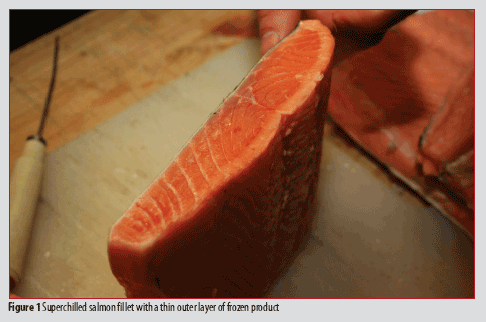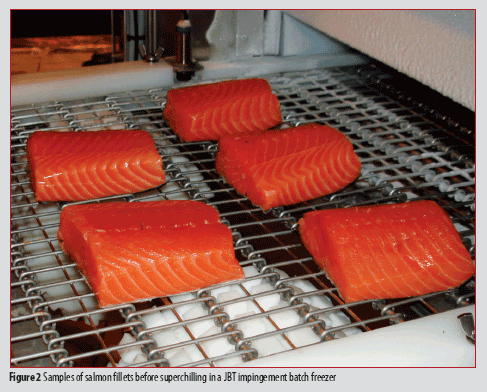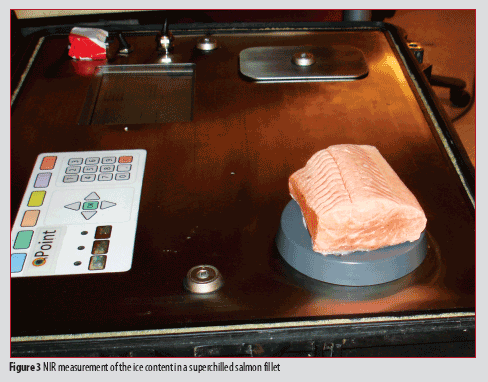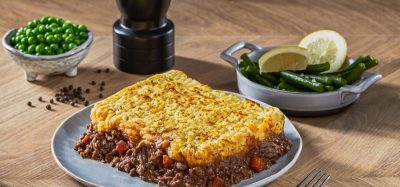Ice fraction assessment by near infrared spectroscopy
- Like
- Digg
- Del
- Tumblr
- VKontakte
- Buffer
- Love This
- Odnoklassniki
- Meneame
- Blogger
- Amazon
- Yahoo Mail
- Gmail
- AOL
- Newsvine
- HackerNews
- Evernote
- MySpace
- Mail.ru
- Viadeo
- Line
- Comments
- Yummly
- SMS
- Viber
- Telegram
- Subscribe
- Skype
- Facebook Messenger
- Kakao
- LiveJournal
- Yammer
- Edgar
- Fintel
- Mix
- Instapaper
- Copy Link
Posted: 26 August 2010 | Astrid Stevik, Research Scientist, SINTEF | No comments yet
The discussion of the energy crisis for a steadily growing population is often limited to scarce amounts of electric power based on more or less environmentally friendly energy sources. However, lack of food, and in particular fresh food, is also part of the current energy crisis. Fresh food is one of the most valuable sources of energy and broad research and technology development is constantly ongoing to protect and utilise fresh food for human consumption in an energy efficient way.
The challenge for the food industry is consequently to conserve and utilise fresh food to give a high quality product, defeating the barriers of costs and varying storage/transport conditions. During the past decade, superchilling of fresh food has come up as an alternative and supplement to traditional conservation methods like freezing and chilling, and the R&D results for superchilling technology are promising.
The discussion of the energy crisis for a steadily growing population is often limited to scarce amounts of electric power based on more or less environmentally friendly energy sources. However, lack of food, and in particular fresh food, is also part of the current energy crisis. Fresh food is one of the most valuable sources of energy and broad research and technology development is constantly ongoing to protect and utilise fresh food for human consumption in an energy efficient way. The challenge for the food industry is consequently to conserve and utilise fresh food to give a high quality product, defeating the barriers of costs and varying storage/transport conditions. During the past decade, superchilling of fresh food has come up as an alternative and supplement to traditional conservation methods like freezing and chilling, and the R&D results for superchilling technology are promising.
The discussion of the energy crisis for a steadily growing population is often limited to scarce amounts of electric power based on more or less environmentally friendly energy sources. However, lack of food, and in particular fresh food, is also part of the current energy crisis. Fresh food is one of the most valuable sources of energy and broad research and technology development is constantly ongoing to protect and utilise fresh food for human consumption in an energy efficient way.
The challenge for the food industry is consequently to conserve and utilise fresh food to give a high quality product, defeating the barriers of costs and varying storage/transport conditions. During the past decade, superchilling of fresh food has come up as an alternative and supplement to traditional conservation methods like freezing and chilling, and the R&D results for superchilling technology are promising.
About superchilling
Superchilling, described as early as 1920, is a method for conserving foods by holding the product at a temperature between –0.5 and –4°C. A thin outer layer of ice is formed during freezing, building a cold-buffer that equalises in the product during storage at superchilled conditions. For many fresh foods, like fish, meat and poultry products, superchilling results in better quality compared to conventional chilling. A superchilled salmon fillet is shown in Figure 1, illustrating the ice-layer visible only shortly after superchilling. After temperature equalisation, the product has the same appearance as a chilled fillet, and so far, sensory judges have not been able to distinguish superchilled samples from chilled samples. At superchilling temperatures, the microbial activity is drastically reduced. Superchilling has proven to double the shelf life of fish, meat and poultry products compared with traditional ice storage.
Several methods for superchilling exists and the most common are continuous- or batch-operated air-tunnel freezers (illustrated in Figure 2 on page 20) and CO2 freezers. The concept is simple and the advantages obvious, but the technology has yet to experience a broad breakthrough in the industry. In spite of the obvious benefits due to an extended shelf-life, the fear that the physical and sensory quality of superchilled products would be reduced compared to traditionally chilled products has been deeply rooted in many communities. Cost and energy efficiency questions and objections to the technology have also been raised. Recent research shows that the superchilling concept is indeed very competitive, both with respect to costs, energy efficiency and end product quality. Caution and scepticism is about to be overcome, and an ‘industrial revolution’ for the superchilling concept seems to be on its way.
About ice fraction
Ice fraction, in the fresh food context, is a measure of the amount of ice in the product. For a frozen product this fraction could be i.e. 50 – 80 per cent, while for superchilled product, the ice-fraction will normally be in the range of 5 – 20 per cent.
It has been shown that the amount and distribution of ice in superchilled products prior to further processing greatly affects the process capacity and yield, as well as the product quality, suggesting that an optimum ice content and distribution exists. Ice fraction is currently measured by means of a time consuming and destructive calorimetric method. In order to enable online control of the ice fraction during superchilling, there is a need for a more efficient non-contact, online method for ice fraction assessment.
Automation is the keyword for current and future superchilling process lines. To control the process it is of utter importance to achieve a high quality end product, but some important factors need to be controlled during superchilling. The vendors of freezers have made it possible to fine-tune all production parameters in the chilling process, but one challenge still remains – the fresh food product is biological, with great individual variations – even for pieces of exact same geometry and weight. Efficient control and monitoring of the ice fraction will be a great step forward when establishing automated superchilling production.
About near infrared spectroscopy (NIR)
Near-infrared spectroscopy (NIR) is a fast and non-destructive technique providing multi-component analysis of both the physical properties and the chemical composition of food and other materials. It covers the wavelength range from the mid infrared down to the visible region (approximately 800 nanometres to 2,500 nanometres). NIR is commonly used for fat, water, protein and sugar assessment in food. It is well known that the NIR spectrum is affected by temperature and this effect has been applied to temperature monitoring. Few works have been performed on ice fraction measurements by NIR, but since the method is non-destructive, highly efficient and easy to implement, this kind of measurement could be the future way to control and monitor a superchilling production line. The difference in light absorption between liquid and solid water in the NIR spectra is the basis for the proposed NIR method for ice fraction measurement.
In NIR transflection, the light from the source enters, transmits through and leaves the product at the same side making it suitable for conveyor belt applications. A separating shield is used to prevent direct reflections from the sample and direct illumination from the source from reaching the detector. Depending on the illumination, optics and the sample features, the NIR scanning can probe approximately one to three centimetres into the sample.
Recent research on superchilled salmon
The Norwegian research institute SINTEF Energy is a leading community within research on superchilling of fresh food, focusing on the cold-chain, thermodynamic changes and product quality of fresh food. Through close cooperation with Norwegian and international industry, as well as Norwegian Universities, broad research and studies on superchilling has been performed during the past decades. Correspondingly, SINTEF Information and Communication Technology (ICT) is a leading community within optical measurements systems and data analyses. SINTEF Energy, SINTEF ICT, the Norwegian University of Science and Technology, the Norwegian University of Life Sciences and Norwegian industrial actors have for the past three years joined forces to research and develop new technology to enhance automation of superchilling production lines.
Ice fraction measurements by NIR
In order to control the product quality there is a need for online measurements of ice fraction and distribution in inhomogeneous products. Moreover, automatic handling of such superchilled products is currently commercially unavailable. Consequently, several pilot-scale studies on salmon fillets (example product) were performed aiming at developing a new method for monitoring superchilled product of varying form and consistency. Near infrared spectroscopy (NIR) transflection mode was used to determine the ice level in super-chilled salmon, scanning approximately 1.5 centimetres into the fillets. The salmon fillets were superchilled in a JBT impingement batch freezer at -24°C to target ice contents of 10 per cent, 15 per cent and 30 per cent. The ice fraction was measured both calorimetrically (reference method) and online by means of a QVision NIR Scanner. By using the imaging scanner, the spatial distribution of the ice was obtained (illustrated in Figure 3 on page 22).
The scanner measured multispectral images with 15 wavelengths, ranging from 760 nanometres to 1040 nanometres with a spectral resolution of approximately 20 nanometres. Statistical analysis of the multi-spectral data was performed with software package Unscrambler 9.7, giving a PLS model that showed good correlation (95 per cent).
The regression coefficient shows four distinct peaks indicating variance around 1000 nanometres, 940 nanometres, 820 nanometres and 760 nanometres. The first two peaks represent the shift of the water peak at 980 nanometres, while the third and fourth peaks indicate systematic change near the red wavelength in the visible region.
It can be seen that the ice content calculated by the model for each fish is very close to that of the reference value. The variations within the images are mainly due to the difference in fat content between the loin and the belly of the fish, which causes slight variations in the spectra where fat absorbs at 920 nanometres.
The storage study for salmon fillets confirmed quality results with a microbiological shelf life of 15 – 17 days with only minor differences in values for drip loss and water holding capacity between superchilled and chilled samples.
The low resolution NIR spectrum obtained by the QVision Scanner contained enough information to allow on-line measurement of the ice fraction in salmon fillets with low prediction error (2.5 per cent). Consequently, the studies have given the foundation for development of a new online method that measures the average ice content and distribution of a fresh food. By measuring the ice fraction at a product level, a more accurate superchilling process is achievable -allowing better control on product quality parameters.
Beyond state of the art – future research
The technical equipment needed to install NIR scanners for on-line or at-line use is already available. NIR scanners are currently used for many industrial application areas in the food industry, i.e. for temperature control, water and fat content measurements. When it comes to superchilled process lines, validation of the NIR scanner adapted to the respective fresh food product in question is needed for correct monitoring of the ice fraction.
It has been a common apprehension that hitting the aimed ice fraction within very narrow limits is necessary to ensure a uniform physical quality of the end product (i.e. same level of drip loss). However, recent research contradicts this assumption, showing that within a quite broad range for the ice fraction (5 – 20 per cent ice), the physical product quality remains approximately the same. As the ice fraction increases above 30 per cent, a significant increase in the drip loss is seen for the superchilled end product.
Future research will focus on technology development and transfer of NIR scanning for an even wider range of application areas in the production quality control and monitoring of different fresh food products, on-line ice fraction measurements of superchilled fresh food being one of these areas.
Industrial implementation
There are numerous advantages related to automated superchilled production with control of the most important raw material parameters. An increase of the microbiological shelf life of fish by 100 per cent constitutes brand new possibilities and frames for distribution and sale of the fresh product. The increased shelf life can open up new markets, extend the product portfolio and significantly reduce transport costs. A superchilled cooling chain eliminates the need for ice in the fresh food boxes during transport. For a normal trailer-load with fresh fish, ice will constitute approximately 20 per cent of the load. Superchilled transport doesn’t only eliminate the costs related to producing the ice, but can also reduce the need for extensive transport by plane and increase the product volumes for each transport batch considerably.
Superchilling can also improve the raw material outcome as the superchilled products become ‘stiffer’ and more uniform, and hence easier to handle for the process machines.
In the food industry, monitoring and quality control of the production lines is emphasised to ensure a safe, high-quality end product. For the fresh food industry, this quality assurance can be very challenging as the raw material is of animal origin, introducing a great extent of biological diversity into the manufacturing process. This diversity needs to be handled. By enabling on-line control of the most important process parameter in a superchilling process line, continuous or sample based NIR measurement of the ice fraction of food products food may be the future way for a safe and efficient processing of superchilled fresh foods of many kinds.






About the author
Astrid Stevik
Astrid Stevik was educated as a civil engineer in biochemistry and process engineering from the Norwegian University of Science and Technology in 1999. She was employed by Nycomed Amersham / GE Healthcare as a Scientist and Project Manager, before joining the research foundation SINTEF Energy in 2007. Her current focus is research and process development on fresh food cold chains as well as project management of international research projects on energy efficiency.







